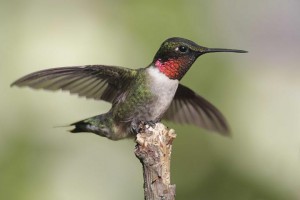
The hummingbird fall migration has begun and when I saw my first hummingbird of the season it was feeding on one of its favorite plants – firebush.
The ruby-throated hummingbird is the most common hummingbird in Florida and can also be a year-round resident in South Florida, but most will spend the winter in Mexico and South America. The black-chinned and rufous hummingbirds can be seen occasionally in Florida during the winter.
Hummingbirds are the smallest of birds, yet for their small size they have one of the largest appetites in the bird world. Hummingbirds feed every 10 to 15 minutes from dawn until dusk, eating more than half their weight in food and 8 times their weight in water. Because of this high need for food, hummingbirds can only survive in areas where nectar and insects are abundant. They use nectar to fuel their insect catching activities. Young hummingbirds are fed a mixture of nectar and insects.
For the health of birds it is very important to avoid the use of insecticides and NEVER spray blooming plants. Systemic insecticides can also poison the birds. The toxins gets into the nectar they drink and also kill the insects they eat. Spiders are especially important to hummingbirds as they use the web to form their nests.
People usually think about hummingbird feeders as the way to get hummingbirds to visit, but there are many problems with feeders. The sugar solution may appeal to their sweet tooth, but it provides little nourishment compared to flower nectar. Sugar substitutes and honey should NEVER be used because it can be fatal to the birds. Sugar solutions must be kept fresh because bacteria grow rapidly in Florida’s heat and humidity, contaminating the solution and killing the birds. Keep feeders out of the sun because the bacteria will grow very fast. Feeder solutions must be changed every 3 to 5 days depending on weather conditions and they must be cleaned each time with hot water and white vinegar only. Do NOT use soap or bleach. Placing feeders near windows is also dangerous for the birds as they travel at speeds up to 30 miles per hour and can crash into windows and die. Feeders are a lot of work and can kill the birds if not properly prepared, monitored, cleaned and hung.
If you want to see hummingbirds in your yard it is best, and easier, to plant flowers. It is important to plant a variety of species and to arrange them in several groupings. Nesting hummingbirds are aggressive and territorial around their food source, so providing more than one grouping allows more birds to feed without conflict. The best flower colors are red, orange and pink. Tubular flowers that are either large and solitary, or in loose drooping clusters are best. At a minimum be sure to provide flowers during their two migration periods – spring and fall.
Following is a list of plants for hummingbirds (Native=N).
Small Trees/ Large Shrubs: Bottlebrush, Powderpuff, Buttonbush (N), Peregrina, Yellow Elder, Sweet Viburnum, Necklace Pod (N), Golden Dewdrop, Coral Bean (N), Firebush (N), Pinxter Azalea (N), Azalea (N=some), Chaste Tree.
Small Shrubs: Firecracker Plant.
Vines: Climbing Aster (N), Cross Vine (N), Trumpet Creeper (N), Carolina Jessamine (N), Maypop (N), Confederate Jasmine, Coral Honeysuckle (N).
Perennials: Milkweed (N=some), Purple Coneflower (N), Daylily, Shrimp Plant, Jacobinia, Lion’s Ear, Firespike, Pentas, Salvia.
Annuals: Dotted Horsemint (N), Wishbone Flower, Zinnia.
When selecting plants for your landscape always consider the site’s soil pH, moisture and drainage, amount of sun and shade, and space needed for the mature size of the plant. Coastal areas may also need to have salt tolerant plants. Matching plant needs to the site conditions is important for the longevity and health of the plants.
With a little time and effort you can have a beautiful and lively landscape filled with flowers, insects, spiders and birds. It is thrilling to watch the hummingbird’s fast wings beating a mile a minute as it zooms backward or upside down, feeding from flowers or off to find refuge, perhaps, in a tiny nest. Be sure to keep cats indoors as they prey heavily on birds.
For more information about hummingbirds Google “Hummingbirds of Florida IFAS.”
Cornell University: http://www.allaboutbirds.org/guide/Ruby-throated_Hummingbird/id?gclid=CL2juobvisgCFQ8uaQodeBICKA
For more information or help selecting plants, visit your local University of Florida/IFAS Extension at 12520 Ulmerton Road, Largo. The Lawn and Garden Help Desk is open from 8 a.m. to 5 p.m. Monday through Friday. To speak with a horticulturist, call 727-582-2110 on Monday, Tuesday or Thursday from 9 a.m. to noon or 1 to 4 p.m.
You can also order a free copy of “The Florida-Friendly LandscapingTM Guide to Plant Selection and Landscape Design” at http://Watermatters.org
Please visit our website at www.pinellascountyextension.org.
 0
0
